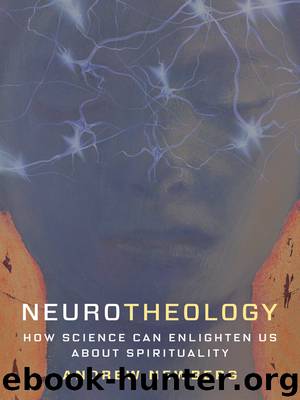Neurotheology by Andrew Newberg

Author:Andrew Newberg
Language: eng
Format: epub
Tags: REL075000, Religion/Psychology of Religion, PSY051000, Psychology/Cognitive Neuroscience & Cognitive Neuropsychology
Publisher: Columbia University Press
Published: 2018-03-26T16:00:00+00:00
HOW MYTHS CHANGE
The ability of myths either to be reinforced or changed within the brain is also an important aspect of myths. If a given story about the world helps us to survive and function well in the world, then we continue to hold on to and support that myth. If a given story leads us to do risky things that threaten our survival, then we change it to something more adaptive. For example, if we develop a story about the world in which snakes are perceived as safe to approach, but each time we approach one we get bitten, we would surely change that particular myth into one where snakes are perceived as dangerous and to be avoided. We might even begin to think about snakes as evil or, in a religious context, representing the devil. The important point here is that as a particular mythic story becomes reinforced or refuted, the myth either grows stronger or is replaced by a new myth. From a neurophysiological perspective, the neural connections that support a particular myth are literally reinforced each time the myth is remembered and supported by new data or experience.2 Interneurons release neurotransmitters that strengthen the connection between neurons that are firing together as a mythic story is elaborated. Neural connections related to myths that become unsupported over time weaken and fall away in favor of neural connections supporting other myths.
We know from many studies of neural development and learning that the more a group of neurons connect and interact with each other, the stronger those connections become. This is how we learn even in elementary school. We repeat that 1 + 2 = 3 several times until the neural connections supporting 1 + 2 = 3 become strong enough to persist. And any time we state that 1 + 2 = 4 and are met with criticism and embarrassment, that particular neural connection weakens. This is also part of the process of neuroplasticity, the ability of the brain, particularly the neurons, to change their function and their connectivity with other neurons.
Religious myths are no exception to this basic process. Religious myths provide us with important concepts regarding how to behave and interact with the world. In many religious traditions, the mythic elements include dietary practices, relationship suggestions, and a basis for general health and spiritual well-being. A person following these myths, who is successful in both relationships and in life, would generally consider the myths to be accurate and successful. This would continuously reinforce the religious myths in that person’s life and, from the neurotheological perspective, in the brain. Similarly, practices such as meditation and prayer that support specific myths also help reinforce the neural connections underlying those myths.
In a sense, this is a “mythic Darwinism” in which the neural connections supporting the most adaptive myths at the present time become strengthened—a “survival of the fittest” myth. It is important to realize that even though many people think that their religious myths are ironclad, virtually every tradition has changed significantly throughout history.
Download
This site does not store any files on its server. We only index and link to content provided by other sites. Please contact the content providers to delete copyright contents if any and email us, we'll remove relevant links or contents immediately.
The Lost Art of Listening by Michael P. Nichols(7157)
Why I Am Not A Calvinist by Dr. Peter S. Ruckman(4045)
The Rosicrucians by Christopher McIntosh(3371)
Wicca: a guide for the solitary practitioner by Scott Cunningham(3038)
Signature in the Cell: DNA and the Evidence for Intelligent Design by Stephen C. Meyer(2875)
Real Sex by Lauren F. Winner(2861)
The Holy Spirit by Billy Graham(2775)
To Light a Sacred Flame by Silver RavenWolf(2668)
The End of Faith by Sam Harris(2627)
The Gnostic Gospels by Pagels Elaine(2390)
Waking Up by Sam Harris(2326)
Nine Parts of Desire by Geraldine Brooks(2275)
Jesus by Paul Johnson(2223)
Devil, The by Almond Philip C(2201)
Heavens on Earth by Michael Shermer(2184)
The God delusion by Richard Dawkins(2179)
Kundalini by Gopi Krishna(2089)
Chosen by God by R. C. Sproul(2052)
The Nature of Consciousness by Rupert Spira(1970)
